|
The early Stoke
Potters & the Newcastle canal:
The works of three
early potters of Spode, Minton & Wolfe (later Adams) were located
alongside the Newcastle-under-Lyme to Stoke canal.
The
Newcastle-under-Lyme to Stoke canal was a 4 mile level canal from
the Trent & Mersey Canal at Stoke to Newcastle-under-Lyme.
It
was authorised by an Act of 1795 and completed in about 1800, part
closed in 1921 and abandoned in 1935 - subsequently filled in.
It was very little used, except by Spode, Minton and Wolfe whose
pottery works were adjacent to it's Stoke terminal. As a dividend
earner, it was a disastrous failure.
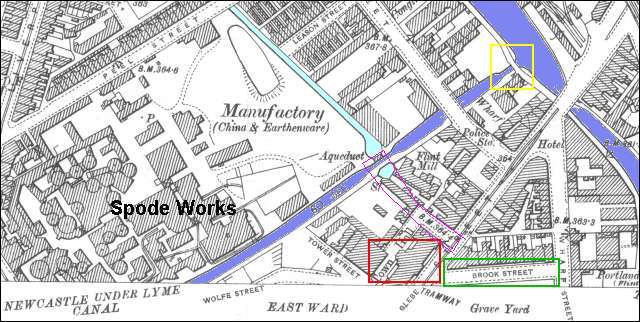
1898 OS map showing
the junction between the Newcastle canal and the Trent and Mersey
canal.
After passing under
Church Street the Newcastle canal runs alongside the Spode works and
behind the Town Hall (red square).
Present day hints of
the earlier existence of the canal are found in "Aqueduct Street"
(purple square) which is alongside the town hall - this name
reflects the presence of the aqueduct which carried the canal over
the fowlea brook (light blue) which went into a culvert under Brook
Street (green square).
The yellow square
show the junction of the Newcastle canal with the Trent & Mersey
canal.

"Aqueduct Street"
alongside Stoke town hall
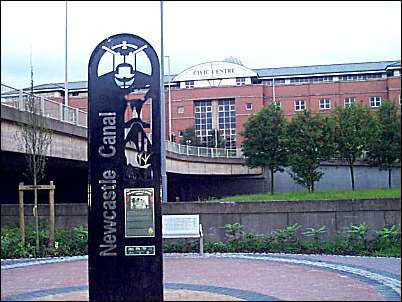
This photo taken from
the footpath on the Trent and Mersey Canal
The sign pinpoints
the junction of the Newcastle Canal where it ran into the Trent &
Mersey Canal near Glebe Street (just opposite the railway station).
Until the early 1970's there was a 100 yard stretch of navigable
Newcastle Canal here which was used as moorings for Stoke Boat Club,
this stretch was wiped out when the huge A500 by-pass was built.
On the far side of the Civic Centre is the Spode Factory and museum.
The three
potters alongside the Newcastle canal:
Thomas Minton
Somewhere about 1788
or 1789 Thomas Minton left London and settled at Stoke,
where for a
time he continued to work as an engraver, at one of the Bridge
houses which had
been built by Thomas
Whieldon, the first partner of Wedgwood.
Four years later,
determining to become a potter, he bought a piece of land and built
for
himself a modest
factory, consisting of one 'bisque' and one 'glost' oven, with a
slip house and other
necessary
accommodation.
It is evident
that he and his partners had become a fairly flourishing concern
by 1800, for in that year their turnover was £17,427.
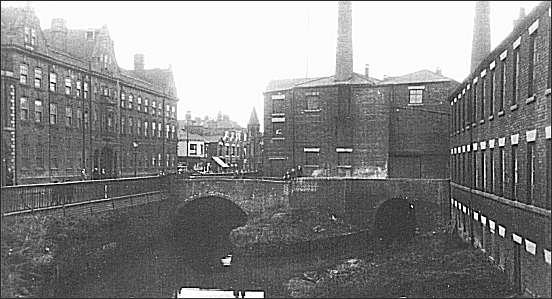
Minton Works
alongside the Newcastle canal -
London Road - Stoke
Above the tunnels of the
Newcastle-under-Lyme to Stoke canal is a flint mill - to the left
are the imposing buildings of Minton, with a long three-storyed
building, rising to four storeys in the centre.
Josiah Spode
Josiah Spode, was an
apprentice of Whieldon in 1749 (as was Josiah Wedgwood).
Spode with a potter
named John Turner worked in the pottery which occupied the very site
on which the Spode factory
stands today.
But in that same year (1762) Turner left and Spode took his place as
manager, continuing in that capacity for eight years; until, in
1770, he took over the works on mortgage,
becoming sole
proprietor and complete owner in 1776.
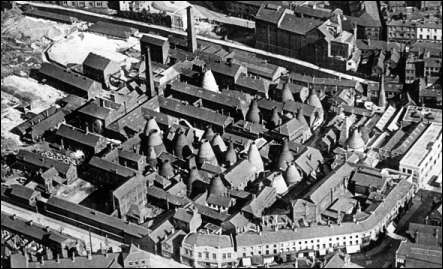
1927 aerial
photo centered on Spode's pottery factory in Stoke
behind Spode's works is the Newcastle Canal
[Stoke-on-Trent Public Health Department]
- click for larger picture -

The Spode pottery works in the centre of the photograph with it's
frontage on Church Street (Green).
The dark blue line behind Spode's works is
the Newcastle Canal
and the light blue line is the Fowlea Brook.
The turquoise line is Elenora Street, the violet line is Hartshill
Road and the pink line is Liverpool Road.
The Big Works of Thomas
Wolfe
Thomas Wolfe had occupied the Big
Works by 1781 it was
on the north-east side of the Newcastle canal -
opposite Spode's pottery works.
In 1818 Thomas
Wolfe's widow Rachel let the two works to William Adams. The famous
Adams family continued to work the old Wolfe factories until c.1862.
In the 1870's Wolfe Street (part of which is now Kingsway) was run
through part of the Big Works.
Thomas Wolfe also manufactured china at the Islington
China works (Liverpool) between 1792 and 1818. Firstly with John
Davenport (1792-1800); then with Miles Mason and John Lucock and
Wolfe & Co (1796-1800); lastly with is son-in-law Robert Hamilton
(1800-1818).
He also had business partnerships with Josiah Spode.
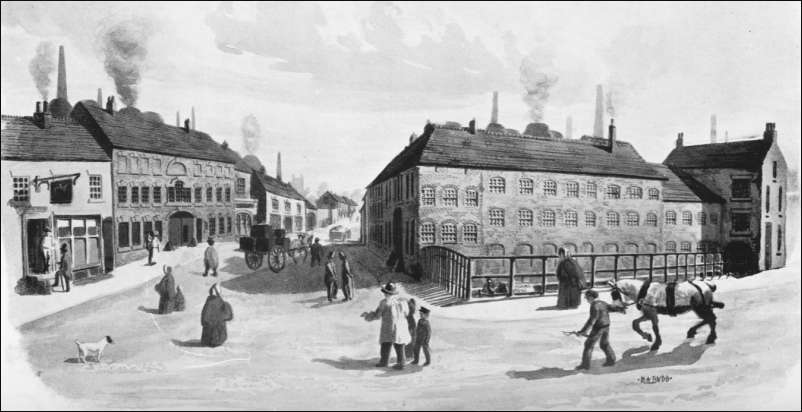
Stoke-upon-Trent c.1819 - The view is along Church Street, London
Road to the right
The
railings in front of the works is the Newcastle Canal - the canal
went underneath
Church Street and the Wheatsheaf Inn and then ran alongside Spode's
and Wolfe's works.
To the immediate left is the Wheatsheaf Public House (a coaching
inn).
Next the Wheatsheaf is Wolfe's "Big Works"
To the right of the picture is Wolfe's china factory - the Bridge
Bank works
picture: "Ten
Generations of a Potting Family"
|
![]()
![]()
![]()
![]()
![]()
![]()